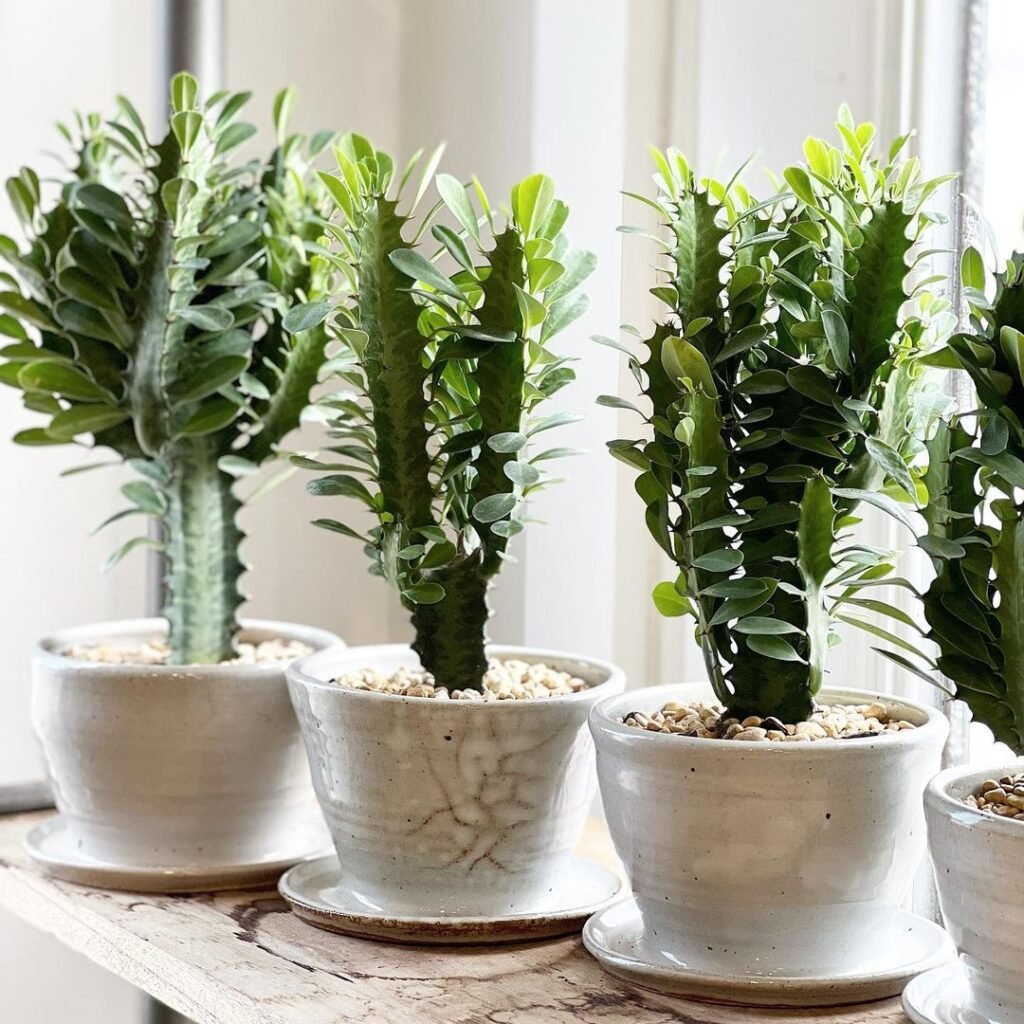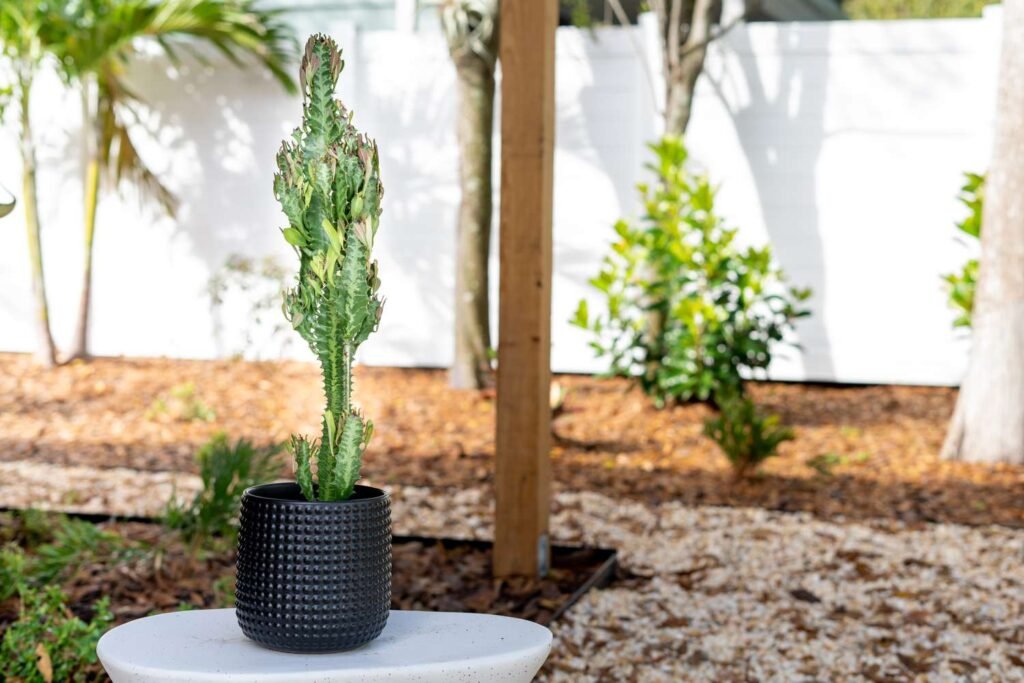Learn all about the low-maintenance African milk tree, a unique succulent with a twisted, triangular trunk and bursts of fleshy leaves. This guide covers care needs and tips for this hardy indoor plant.
Are you looking to add some unique, low-maintenance greenery to your home or office? If so, you should definitely consider getting an African milk tree! This interesting succulent makes a great indoor plant with its thick, twisted trunk and bursts of fleshy leaves.
The African milk tree goes by several other common names too, including the milk bush plant, milk tree euphorbia, or Christ plant. But no matter what you call it, this hardy plant is sure to grab attention with its one-of-a-kind growth habit.
In this guide, you’ll learn all about the African milk tree, including its natural origins, growth patterns, and care requirements for keeping it happy indoors. We’ll also share some tips for common issues like sap leaks. Let’s get started!
What is an African Milk Tree?

The African milk tree (Euphorbia trigona) is a succulent plant species native to parts of Africa like Namibia and South Africa. In its natural desert habitat, it grows as a tall, branching shrub or small tree up to 20 feet high!
As a houseplant, however, the African milk tree typically stays much smaller at around 2-3 feet tall and wide. Its most distinctive feature is the thick, green, and distinctly triangular stem that’s covered with a rough, ridged pattern.
The stem is actually a succulent truck that stores water, similar to a cactus. This allows the plant to go long periods without moisture during drought conditions in its native African climate.
Clusters of thick, oblong green leaves will burst from the ends of the triangular stems, giving the milk tree an interesting sculptural appearance. When mature enough, it may even produce small red flowers.
But where does the “milk tree” name come from? Well, if you snap off a leaf or stem, you’ll notice it oozes a thick, milky white sap. This latex-like liquid is actually toxic if ingested and can cause skin irritation, which is why you’ll want to wear gloves when pruning this plant.
Beyond its cool appearance and sap defenses, the African milk tree is also prized by indoor gardeners for its low maintenance needs and forgiving nature.
How to Care for an African Milk Tree
If you’ve had experience growing other types of succulents, then caring for an African milk tree should be a breeze! Here are some basic care guidelines:
Light:

These plants absolutely need bright, direct sunlight to maintain their thick, compact growth shape and green coloring. At minimum, provide at least 6 hours of sunlight per day. A south or west-facing window is ideal.
Water:
Allow the soil to fully dry out between waterings, then soak the soil thoroughly until excess moisture drains through. Underwatering is preferable to overwatering. Cut back on watering in winter during the plant’s dormancy period.
Soil:

Use a well-draining potting mix made for cacti and succulents. You can also mix in some sand, perlite, or bark to improve drainage and airflow around the roots.
Fertilizer:

Feed every 4-6 weeks during the warm growing season with a liquid fertilizer made for succulents and cacti. In winter when growth is slow, hold off on feeding.
Temperature:

Average household temperatures between 65-80°F are perfect for these heat-loving plants. However, avoid letting temperatures drop below 50°F or else damage and stunted growth may occur.
Pot Size:

Provide a small, well-draining pot with drainage holes. And be patient – these plants actually prefer being slightly root bound! Only repot every 3-4 years in the spring.
Through their low water needs and love of warm, dry conditions, African milk trees are very well-adapted to survive inside the average centrally heated home. As long as you have a sunny spot and don’t overwater it, this hardy plant should stay healthy and last for years.
Tips for Sap Leaks and Pruning
Since this plant stores moisture and nutrients in its thick stems, it’s very prone to “bleeding” a milky white sap whenever cut or damaged. This sappy fluid is actually a natural defense mechanism for the African milk tree, as it contains compounds toxic to animals that may try to eat it.
For humans and pets, the sap can be a skin and eye irritant if it gets on your skin. So if you plan on pruning your African milk tree, take some precautions first:
- Wear gloves, long sleeves, and eye protection
- Place an old towel or tarp underneath to catch any dripping sap
- Use sharp, sterilized pruning shears to make a clean cut
- Seal any cut areas immediately with a dusting of cinnamon or wax to stop sap flow
- Thoroughly clean up any sap spills or leaks with soap and water
Occasional pruning can actually promote thicker, more compact growth on your African milk tree. Simply cut off any stretched, tall sections or remove dead branches as needed in spring during the growing season.
Another benefit of pruning? New stem cuttings from your African milk tree can be easily rooted in soil to propagate more plants! This makes the African milk tree an excellent choice for sharing with fellow plant lovers.
With its funky growth habit and carefree nature, the African milk tree succulent is quickly gaining popularity as an indoor plant for homes and offices. It’s easy to see why – this resilient plant brings a fun, sculptural element to any sunny space!
So if you want to add some unique, low-maintenance greenery to your indoor jungle, give the African milk tree a try. Just be sure to wear gloves when pruning and enjoy the strange beauty of this interesting succulent variety.
Pingback: https://gardenersschool.com/the-unique-african-...
Pingback: The Unique African Milk Tree: An Easy-Care Succ...
Pingback: Calathea Plants: A Guide to Care, Toxicity & Prayer Plant
Pingback: Complete Guide to Growing Dragon Fruit Plants at Home -
Pingback: A Guide to Notable Trees that Start with ‘O’
Pingback: Blue Orchids : Real and Fake – All Your Questions Answered - Gardener's School
Pingback: Monstera Obliqua: A Guide to Caring for the Elusive Delight
Pingback: Guide to Growing the Beautiful Crown of Thorns Plant - Gardener's School